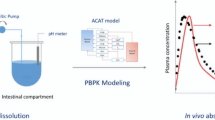Abstract
Purpose. To develop an approach based on computer simulations for the study of intestinal drug absorption.
Methods. The drug flow in the gastrointestinal tract was simulated with a biased random walk model in the heterogeneous tube model Pharm. Res. 16, 87-91, 1999), while probability concepts were used to describe the dissolution and absorption processes. An amount of drug was placed into the input end of the tube and allowed to flow, dissolve and absorb along the tube. Various drugs with a diversity in dissolution and permeability characteristics were considered. The fraction of dose absorbed (F abs ) was monitored as a function of time measured in Monte Carlo steps (MCS). The absorption number An was calculated from the mean intestinal transit time and the absorption rate constant adhering to each of the drugs examined.
Results. A correspondence between the probability factor used to simulate drug absorption and the conventional absorption rate constant derived from the analysis of data was established. For freely soluble drugs, the estimates for F abs derived from simulations using as an intestinal transit time 24500 MCS (equivalent to 4.5 h) were in accord with the corresponding data obtained from literature. For sparingly soluble drugs, a comparison of the normalized concentration profiles in the tube derived from the heterogeneous tube model and the classical macroscopic mass balance approach enabled the estimation of the dissolution probability factor for five drugs examined. The prediction of F abs can be accomplished using estimates for the absorption and the dissolution probability factors.
Conclusions. A fully computerized approach which describes the flow, dissolution and absorption of drug in the gastrointestinal tract in terms of probability concepts was developed. This approach can be used to predict F abs for drugs with various solubility and permeability characteristics provided that probability factors for dissolution and absorption are available.
Similar content being viewed by others
REFERENCES
J. B. Dressman, G. L. Amidon, and D. Fleisher. Absorption potential: estimating the fraction absorbed for orally administered compounds. J. Pharm. Sci. 74:588–589 (1985).
J. B. Dressman and D. Fleisher. Mixing-tank model for predicting dissolution rate control of oral absorption. J. Pharm. Sci. 75:109–116 (1986).
P. Macheras and M. Symillides. Toward a quantitative approach for the prediction of the fraction of dose absorbed using the absorption potential concept. Biopharm. Drug Dispos. 10:43–53 (1989).
P. J. Sinko, G. D. Leesman, and G. L. Amidon. Predicting fraction dose absorbed in humans using a macroscopic mass balance approach. Pharm. Res. 8:979–988 (1991).
D.-M. Oh, R. L. Curl, and G. L. Amidon. Estimating the fraction dose absorbed from suspensions of poorly soluble compounds in humans: a mathematical model. Pharm. Res. 10:264–270 (1993).
L. X. Yu, E. Lipka, J. R. Crison, and G. L. Amidon. Transport approaches to the biopharmaceutical design of oral drug delivery systems: prediction of intestinal absorption. Adv. Drug Del. Rev. 19:359–376 (1996).
L. X. Yu and G. L. Amidon. Saturable small intestinal drug absorption in humans: modeling and interpretation of cefatrizine data. Eur. J. Pharm. Biopharm. 45:199–203 (1998).
G. L. Amidon, H. Lennernas, V. P. Shah, and J. R. Crison. A theoretical basis for a biopharmaceutic drug classification: the correlation of in vitro drug product dissolution and in vivo bioavailability. Pharm. Res. 12:413–420 (1995).
P. Macheras and P. Argyrakis. Gastrointestinal drug absorption: Is it time to consider heterogeneity as well as homogeneity? Pharm. Res. 14:842–847 (1997).
A. Kalampokis, P. Argyrakis, and P. Macheras. A heterogeneous tube model for the study of the small intestinal transit flow. Pharm. Res. 16:87–91 (1999).
M. Fegertholm, Johansson, and H. Lennernas. Comparison between permeability coefficients in rat and human jejunum. Pharm. Res. 13:1336–1341 (1996).
L. X. Yu, J. Crison, and G. L. Amidon. Compartmental transit and dispersion model analysis of small intestinal transit flow in humans. Int. J. Pharm. 140:111–118 (1996).
Author information
Authors and Affiliations
Corresponding author
Rights and permissions
About this article
Cite this article
Kalampokis, A., Argyrakis, P. & Macheras, P. A Heterogeneous Tube Model of Intestinal Drug Absorption Based on Probabilistic Concepts. Pharm Res 16, 1764–1769 (1999). https://doi.org/10.1023/A:1018918402237
Issue Date:
DOI: https://doi.org/10.1023/A:1018918402237




